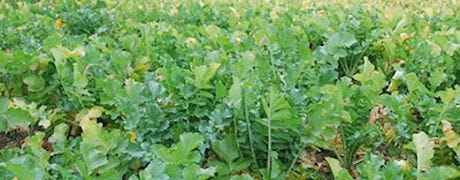
Iowa farmers are planting more acres to cover crops each fall for erosion control and to help save nutrients—keeping nitrate and phosphorus from running off of fields and entering lakes, streams and rivers. Cover crops also play a role in pest management in fields. In that regard, there are two aspects of cover crops that relate to the biology and management of soybean cyst nematode (SCN).
First question—Are cover crops unintentional hosts for SCN? That is, with the additional amount of roots in the soil when you plant cover crops, are the cover crops providing a way for the SCN population to increase? Does SCN feed on cover crop roots and survive and thrive?

DO COVERS HELP CONTROL SCN?: Or do they make it worse? Cover crops, such as tillage radish shown here, are being grown in Iowa for soil conservation purposes. There are some possible effects on soybean cyst nematode infestation, but magnitude and consistency of the SCN effects have yet to be determined.
Second question—This question is just the opposite of the first one. Can cover crops reduce SCN numbers? If planted in a field, do cover crops somehow interfere with SCN's ability to function in the soil?
Greg Tylka, Iowa State University Extension plant pathologist and nematologist, and his research team are conducting new studies to help find answers to these and related questions. He explains the results so far, as to what is and is not known, as he provides the following information and observations.
Are cover crops inadvertent hosts to SCN?
The most immediate point of interest about the relationship between cover crops and SCN is whether the cover crop plants can serve as inadvertent or unintentional hosts for the nematode. Of greatest concern would be leguminous plants used as cover crops because there are almost 100 different legume species reported in the scientific literature to be hosts (support reproduction) of SCN.
In the past several months, two greenhouse experiments were conducted at Iowa State University to determine if common legume species used as cover crops supported reproduction of SCN. Berseem clover, cowpea, crimson clover, red clover (three different varieties), sweet clover, white clover (two different varieties), Austrian winter peas, and field peas were grown in soil infested with SCN collected from a field in north central Iowa and one in southeast Iowa.
~~~PAGE_BREAK_HERE~~~
Studies show these legumes likely aren't hosts for SCN
The seeds for most of the cover crop plants that were grown in this study were provided by Cover Crop Solutions, LLC. After the cover crop plants were growing in the SCN-infested soils for 30 days, SCN reproduction was assessed by carefully observing the roots of each plant for the presence of adult SCN females. Almost no SCN reproduction occurred. There were six to 12 replicated plants of each of the different types of cover crops tested in the two experiments.
"Results of the experiments indicate these legumes should not serve as inadvertent hosts for SCN, if these legumes are used as cover crops," says Tylka. "These legumes likely aren't hosts for SCN."
The opposite question: Can cover crops reduce SCN numbers?
What about reducing SCN numbers in the soil? Some farmers and agronomists are asking if cover crops can lower SCN population densities in fields in Iowa.
Tylka says there are several reports of cover crops reducing plant-parasitic nematode population densities, including some reports mentioning reduction in SCN numbers.
"It is biologically possible that cover crops may reduce nematode numbers, particularly for cruciferous plants including cabbage, rapeseed, mustards and radishes," Tylka explains. The green leaf tissues of these plants contain compounds called glucosinolates. When the plant tissues are incorporated in the soil, the glucosinolates can be broken down by enzymes to produce nematicidal thiocyanate and isothiocyanate gas. The extent to which this phenomenon can reduce SCN egg population densities in infested fields in Iowa is not known at this time, he says.
Can cover crops serve as a "trap crop" for SCN?
Another possible nematode-suppressing aspect of cover crops being discussed is the potential for the plants to serve as a "trap crop" for SCN. In this scenario, numerous nematode juveniles would enter the roots of trap crops, but the juveniles are unable to feed and reproduce once inside, thereby starving in place within the roots. The most well-known example of a plant serving as a trap crop for plant-parasitic nematodes is French marigold and the root-knot nematode.
~~~PAGE_BREAK_HERE~~~
What about SCN? "To date there are no published scientific reports demonstrating that cover crops serve as trap crops for SCN," says Tylka.
A third mechanism by which cover crops have been described as reducing SCN numbers is by the roots producing compounds that stimulate SCN eggs to hatch. The hatched SCN juveniles then would starve due to the absence of actively growing soybean roots upon which to feed. "There is no evidence currently that such a phenomenon occurs with SCN and cover crops," says Tylka.
Summing up: Cover crops may reduce nematode population densities and that can be an added benefit of planting cover crops in a field. "But the magnitude and consistency of the effects on soybean cyst nematode has yet to be demonstrated," Tylka says. "And, you need to consider that the effect of the cover crop will vary greatly depending on the type of cover crop being grown; and it may vary among the different varieties of a plant within a cover crop type."

Greg Tylka is a professor with extension and research responsibilities in management of plant-parasitic nematodes in the Department of Plant Pathology and Microbiology at Iowa State University. He can be reached at [email protected] or 515-294-3021.
About the Author(s)
You May Also Like




